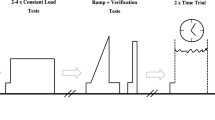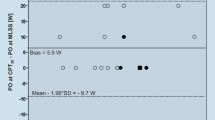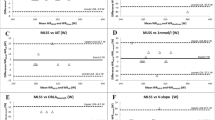Summary
This study was undertaken to compare the contribution of both the anaerobic threshold (AT) and onset of blood lactate accumulation (OBLA) with endurance performance in eleven non-endurance trained active male adults. AT determination was based upon both blood lactate and gas exchange criteria, while OBLA was determined as the point corresponding to a blood lactate concentration of 4 mmol·l−1. A dependent t-test revealed significantly higher values for OBLA related variables as compared with corresponding AT related variables, thereby validating the comparison of these two categories of variables in relation to endurance performance. Approximately 67, 60, 37, and 50% of the variance in endurance performance were accounted for by \(\dot V\)O2 (ml · kg−1 · min−) AT-WR, OBLS-\(\dot V\)O2 (ml · kg−1 · min−), and OBLA-WR, respectively. When AT-HR (X2) was added to the \(\dot V\)O2 (X1) as another predictor, the contribution of these variables to endurance performance increased appreciably to 84%. The resultant multiple regression equation was Y=−4.564 X1+2.68 IX2+90.6 (SEE=9.9 s). Consequently, it is suggested that variables related to an abrupt increase in blood lactate, together with several gas exchange responses, could explain endurance performance in a shorter distance to a greater extent than variables related to a rigid threshold of 4 mmol·l−1.
Similar content being viewed by others
References
Davis JA, Vodak P, Wilmore JH, Vodak J, Kurtz P (1976) Anaerobic threshold and maximal aerobic power for three modes of exercise. J Appl Physiol 41: 544–550
Davis JA, Frank MH, Whipp BJ, Wasserman K (1979) Anaerobic threshold alterations caused by endurance training in middle-aged men. J Appl Physiol 46: 1039–1046
Farrell PA, Wilmore JH, Coyle EF, Billing JE, Costill DL (1979) Plasma lactate accumulation and distance running performance. Med Sci Sports 11: 338–344
Fredholm BB (1971) Fat mobilization and blood lactate concentration. In: Pernow B, Saltin B (eds) Muscle metabolism during exercise. Plenum Press, New York, pp 249–255
Hickson RC, Rennie MJ, Conlee RK, Winder WW, Holloszy JO (1977) Effects of increased plasma fatty acids on glycogen utilization and endurance. J Appl Physiol 43: 829–833
Jacobs I (1981) Lactate, muscle glycogen and exercise performance in man. Acta Physiol Scand [Suppl] 495
Jacobs I, Sjödin B, Kaiser P, Karlsson J (1981) Onset of blood lactate accumulation after prolonged exercise. Acta Physiol Scand 112: 215–217
Jacobs I, Kaiser P (1982) Lactate in blood, mixed skeletal muscle, and FT or ST fibers during cycle exercise in man. Acta Physiol Scand 114: 461–466
Kindermann W, Simon G, Keul J (1979) The significance of the aerobic-anaerobic transition for the determination of work load intensities during endurance training. Eur J Appl Physiol 42: 25–34
Kindermann W, Schramm M, Keul J (1980) Aerobic performance diagnostics with different experimental settings. Int J Sports Med 1: 110–114
Komi PV, Ito A, Sjödin B, Wallenstein R, Karlsson J (1981) Muscle metabolism, lactate breaking point, and biomechanical features of endurance running. Int J Sports Med 2: 148–153
Kumagai S, Tanaka K, Matsuura Y, Matsuzaka A, Hirakoba K, Asano K (1982) Relationships of the anaerobic threshold with the 5 km, 10 km, and 10 mile races. Eur J Appl Physiol 49: 13–23
MacDougall J (1977) The anaerobic threshold: its significance for the endurance athlete. Can J Appl Sport Sci 2: 137–140
Rennie MJ, Winder WW, Holloszy JO (1976) A sparing effect of increased plasma free fatty acids on muscle and liver glycogen content in the exercising rat. Biochem J 156: 647–655
Robinson T, Sucec AA (1980) The relationship of training intensity and anaerobic threshold to endurance performance. Med Sci Sports Exerc 12: 124–125
Rusko H, Rahkila P (1982) Maximum oxygen uptake, anaerobic threshold, and skeletal muscle enzymes in male athletes. In: Komi PV (ed) Exercise and sport biology. Human Kinetics Publishers, Champaign Illinois, pp 68–75
Sjödin B (1982) The relationships among running economy, aerobic power, muscle power, and onset of blood lactate accumulation in young boys (11–15 years). In: Komi PV (ed) Exercise and sport biology. Human Kinetics Publishers, Champaign Illinois, pp 57–60
Sjödin B, Jacobs I (1981) Onset of blood lactate accumulation and marathon running performance. Int J Sports Med 2: 23–26
Sjödin B, Schéle R (1982) Oxygen cost of treadmill running in long distance runners. In: Komi PV (ed) Exercise and sport biology. Human Kinetics Publishers, Champaign Illionois, pp 61–67
Skinner JS, McLellan TH (1980) The transition from aerobic to anaerobic metabolism. Res Q Exerc Sport 51: 234–248
Svedenhag J, Sjödin B (1982) Physiological characteristics of elite middle and long distance runners. Med Sci Sport Exerc 14: 104
Tanaka K, Matsuura Y, Moritani T (1981) A correlational analysis of maximal oxygen uptake and anaerobic threshold as compared with middle and long distance performance. J Phys Fit Japan 30: 94–102
Tesch PA, Sharp DS, Daniels WL (1981) Influence of fiber composition and capillary density on onset of blood lactate accumulation. Int J Sports Med 2: 252–255
Tesch PA, Daniels WL, Sharp DS (1982) Lactate accumulation in muscle and blood during submaximal exercise. Acta Physiol Scand 114: 441–446
Thorland W, Sady S, Refsell M (1980) Anaerobic threshold and maximal oxygen consumption rates as predictors of cross country running performance. Med Sci Sports Exerc 12: 87
Wasserman K, Whipp BJ, Koyal SN, Beaver WL (1973) Anaerobic threshold and respiratory gas exchange during exercise. J Appl Physiol 35: 236–243
Weltman A, Katch V, Sady S, Freedson P (1978) Onset of metabolic acidosis (anaerobic threshold) as a criterion measure of submaximal fitness. Res Q 49: 218–227
Withers RT, Sherman WM, Miller JM, Costill DL (1981) Specificity of the anaerobic threshold in endurance trained cyclists and runners. Eur J Appl Physiol 47: 93–104
Author information
Authors and Affiliations
Rights and permissions
About this article
Cite this article
Tanaka, K., Matsuura, Y., Kumagai, S. et al. Relationships of anaerobic threshold and onset of blood lactate accumulation with endurance performance. Europ. J. Appl. Physiol. 52, 51–56 (1983). https://doi.org/10.1007/BF00429025
Accepted:
Issue Date:
DOI: https://doi.org/10.1007/BF00429025




